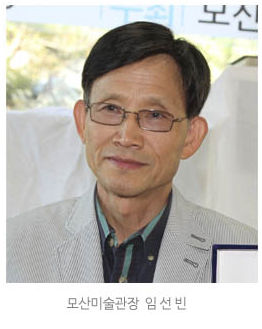오석
Black sand Stone

오석(black sand stone)
보령오석은 세계유일의 퇴적 흑사암이다. 수억년 흑(黑)모래가 퇴적된 것이 지열로 군고구마처럼 구워져서 만들어진 돌이며, 미세한 황토 흙으로 감싸여서 마치 보석처럼 쌓아둔 군고구마를 캐내는 것 같다.
석질은 퇴적 흑사암 이기 때문에 흑사(검은모래)와 규사(흰 차돌)성분이 함유되어있어 갈면 갈수록 유리같이 깨끗한 푸른색의 검정빛이 나고, 쪼면 흰색으로 변하여 영원히 지워지지 않는다는 특성이 있다. 그래서 음영처리가 가능하다하며 옛 선조들이 비석으로 글을 남기는 일에 보물처럼 사용하였고 현대에는 조각용으로도 사용하고 있다. 선조들의 말에 의하면 보령 오석은 세월이 지날수록 흠을 감추고 다른 돌들은 흠을 내어논다는 속설이 있으며 돌중에서 유일하게 세월이 가도 싫증나지 않으며 질감이 좋고 느낌이 좋다 라고들 표현한다.
무게는 다른 돌에 비해 무거운 편이며 제실(퇴적된 선)로는 전봇대를 만들 정도로 질기고 강하다.
사용연대는 고려시대 이후부터로 추정되고 약 1200년된 최치원의 오석비가 성주사지에 지금도 그 내용을 잘 전달하고 있다. 이 돌은 그 당시 웅천 큰양지 걷돌로 추정되며 재통이 있는 B급의 돌이여서 일부 훼손된 것이 아쉽다. 하지만 아직 A급 돌이 보령에 많이 매장되어있으며 옛날부터 나라의 중요한 비석을 세우는데 많은 돌을 캐내었다 하여 별명이 나라 구뎅이 라는 곳에서 지금도 생산되고 있다.
거문석산 채석인
모산조형미술관 설립자 임항렬
보령오석은 세계유일의 퇴적 흑사암이다. 수억년 흑(黑)모래가 퇴적된 것이 지열로 군고구마처럼 구워져서 만들어진 돌이며, 미세한 황토 흙으로 감싸여서 마치 보석처럼 쌓아둔 군고구마를 캐내는 것 같다.
석질은 퇴적 흑사암 이기 때문에 흑사(검은모래)와 규사(흰 차돌)성분이 함유되어있어 갈면 갈수록 유리같이 깨끗한 푸른색의 검정빛이 나고, 쪼면 흰색으로 변하여 영원히 지워지지 않는다는 특성이 있다. 그래서 음영처리가 가능하다하며 옛 선조들이 비석으로 글을 남기는 일에 보물처럼 사용하였고 현대에는 조각용으로도 사용하고 있다. 선조들의 말에 의하면 보령 오석은 세월이 지날수록 흠을 감추고 다른 돌들은 흠을 내어논다는 속설이 있으며 돌중에서 유일하게 세월이 가도 싫증나지 않으며 질감이 좋고 느낌이 좋다 라고들 표현한다. 무게는 다른 돌에 비해 무거운 편이며 제실(퇴적된 선)로는 전봇대를 만들 정도로 질기고 강하다.
사용연대는 고려시대 이후부터로 추정되고 약 1200년된 최치원의 오석비가 성주사지에 지금도 그 내용을 잘 전달하고 있다. 이 돌은 그 당시 웅천 큰양지 걷돌로 추정되며 재통이 있는 B급의 돌이여서 일부 훼손된 것이 아쉽다. 하지만 아직 A급 돌이 보령에 많이 매장되어있으며 옛날부터 나라의 중요한 비석을 세우는데 많은 돌을 캐내었다 하여 별명이 나라 구뎅이 라는 곳에서 지금도 생산되고 있다.
거문석산 채석인
모산조형미술관 설립자 임항렬
